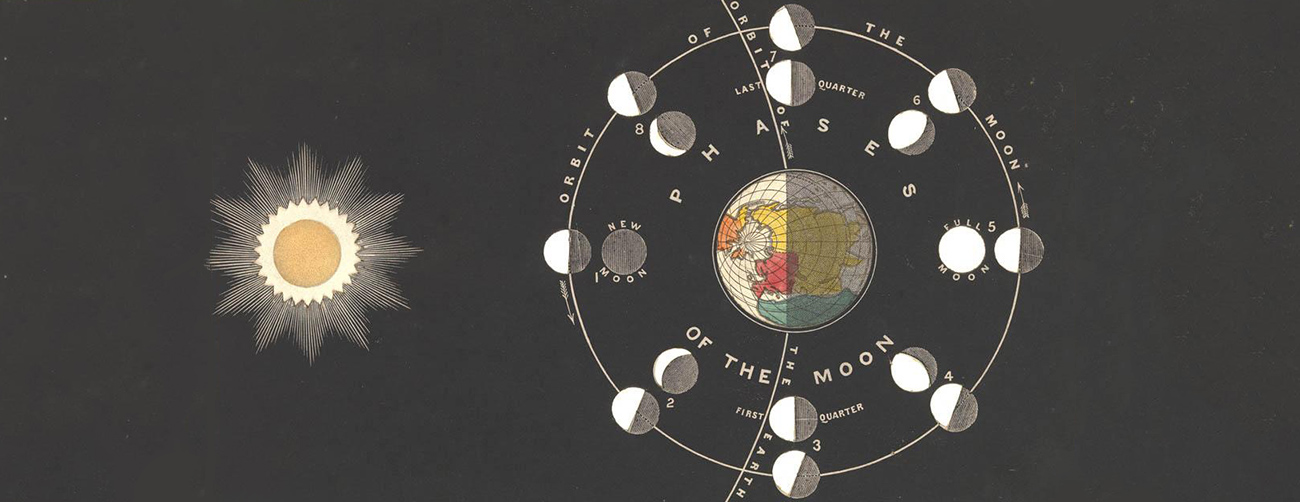Photo: The phases of the moon. Credit: Royal Museums Greenwich
In Indic Civilizations – the word ‘KALA’ which means both TIME and SPACE! Time and space are two wonders. The term space-time stands for the meaning that the space and time are not two separate entities but are the manifestation of a single entity.
The Indus valley civilization had professional astronomers, called ‘nakshatra darshaks’ or ‘star gazers’, who meticulously observed and recorded the phases of the moon in reference to fixed constellations of stars. This method of calculation and its precision, sharply distinguishes Indian astronomy. Indian understanding of physics was informed not only by astronomy and terrestrial experiments but also by speculative thought and by meditations on the nature of consciousness! The detailed concept of time – much smaller than a second (10^-6 of a second) to the age of the Universe was expressed with specific Sanskrit words. A Day and a Year were finely divided, to express several aspects of those durations! The precision, accuracy and scientifically-proven system of Hindu calendar became popular.
Panchanga –The Ancient Hindu calendar
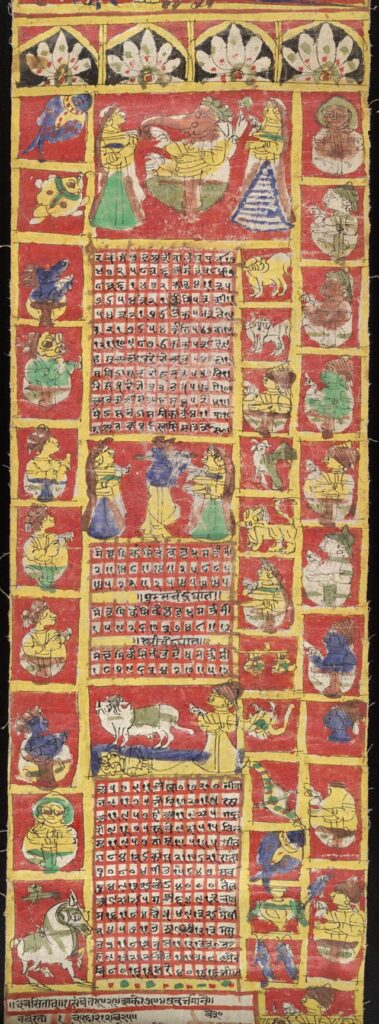
The Indian calendar is known by the Hindu word “panchanga“. This panchanga – traditional Indian calendar places science in a cultural context. Panchanga is an ancient time reckoning system used for, among other things, determining the dates of Hindu festivals. In India a variety of luni-solar calendar is followed and the dates of many, but not all, Hindu holidays are determined according to the lunisolar calendar. In most cases, the festivals coincide with the Full Moon or the New Moon, or they are celebrated on the day after the Moon phase. Holidays based on the Hindu calendar include Maha Shivaratri, Holi, Guru Purnima, Ganesh Chaturthi, and Diwali.
There are two main calendars in common use in India today, the Vikram Samvat with a zero point of 57 BC and the Shaka Samvat with a zero point of 78 AD. They are used for calculating the dates of all Hindu festivals like Diwali and Holi. The Indian National Calendar or Shaka Calendar, the official standardized calendar of India since 1957, represents one of many variations of the Hindu calendar.
Photo: A page from the Hindu calendar 1871-72. Credit: Wikipedia
Multi-dimensional Luni-Solar Calendar system
The Hindu calendar is known as a lunisolar calendar. Indian system is precise and scientific as it offers a multi-dimensional method of structuring time. The Indian calendar is ingeniously based on both the sun as well as the moon. The Rig Veda, cites months being lunar, but years luni-solar. It uses a solar year, but divides it into 12 lunar months. In Indian calendar days are defined by the movement of the Sun and the Moon. A month is defined by the movement of the moon. And the year, again is defined by the movement of the Sun
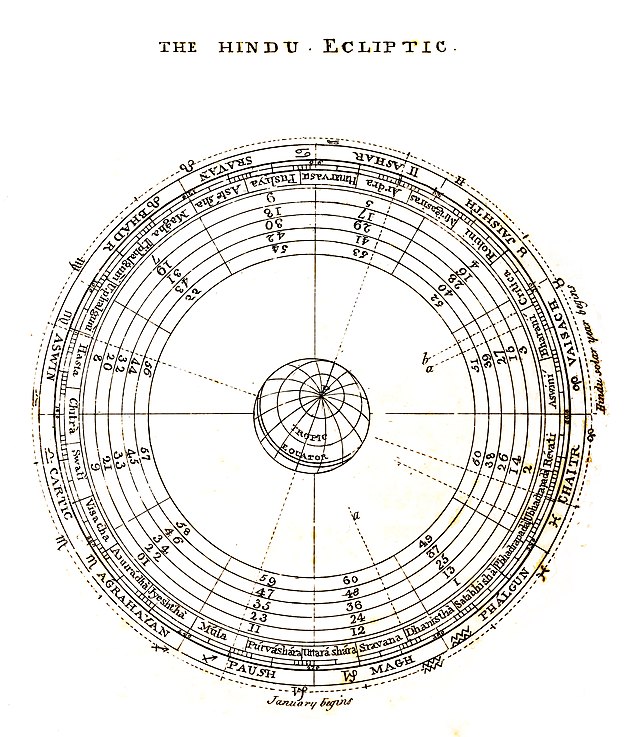
12 Lunar Months
A lunar month is the time required for the moon to orbit once around the earth and pass through its complete cycle of phases. The lunar month is exactly 29 days 12 hours 44 minutes and 3 seconds long and twelve such months create a lunar year of 354 days 8 hours 48 minutes and 36 seconds.
Additional / Extra Month
Since a period of twelve lunar months fall short of a solar year by 11 days, so to match the lunar months with the solar year, the practice started of inserting an additional month to the calendar at every 32.5 months (approximately every 2½ years) on an average interval. This month is known as the “Adhika Māsa “. An intercalary month is mentioned in the Rig Veda {Vedamãso dhrutavrato dvãdasha prajãvatah; vedã ya upajãyate. (I/25:8)}. Such an adjustment assures that the seasons, festivals, etc. retain their general position to the solar year.
A lunar month is divided into 30 lunar days. Lunar days in the Indian calendar are called tithis. They, too, are calculated very scientifically using the difference of the longitudinal angle between the position of the sun and the moon. Each tithi is defined by the time required for the longitude of the Moon to increase by 12° over the longitude of the sun. The Vedic astronomers had knowledge the orbit of the moon around the earth was elliptical and calculated the duration of each lunar day (or tithi).
Photo: Hindu Calendar. Credit: Samuel Davis. Wikimedia Commons
The two-part Lunar Month
In the Indian calendar, the month follows the phases of the moon. Each month is divided into the two cycles (one for the waning moon known as ‘Krishna paksh’ and one for the waxing moon known as ‘Shukla Paksh)’ of the moon (new moon to full moon and back). Each paksh is consisting of 15 Tithis. The period of the new moon is called “amavesya” and the period of the full moon is called “purnimavesya”. This system of dissecting a month equally into two, and again into 15, is a truly ingenious, logical and simple.

In most areas in northern India, the month starts on the Full Moon, while most people in southern India count the days of the month from one New Moon to the next.
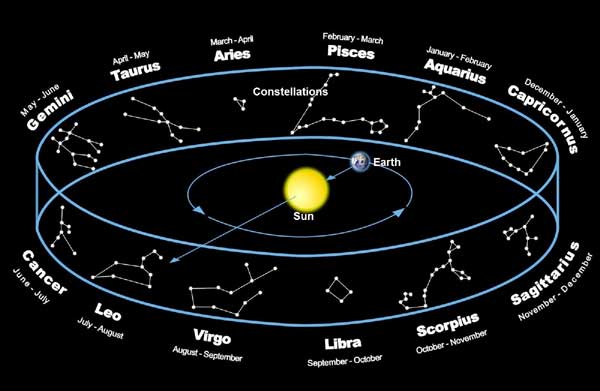
A Solar Year Made of 12 Lunar Months
The Indian calendar defines the year by the movement of the Sun. Lunar months are formulated in accordance with the successive entrances of the sun into the 12 rashis or the signs of the zodiac derived from the 12 constellations marking the path of the Sun. While the lunar months are commonly used to determine religious holidays and rituals, the solar time reckoning usually serves as the basis for civil purposes, so solar months are also referred to as civil months.
Photo: The signs of the zodiac derived from the 12 constellations marking the path of the sun. Credit: Askastrologer.com
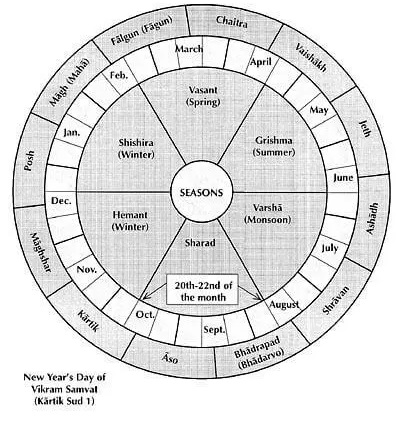
Seasons within the Hindu calendar
The 12 lunar months of a solar year are divided into six ritus (seasons), each comprising of approximately two months. Since the seasons are solar based, each of the six seasons —
- Sharad (late monsoon)
- Hemant (early winter)
- Shishir (winter)
- Vasant (spring)
- Grishma (summer)
- Varsha (monsoon).
The Hindu calendar recognizes the importance of the summer solstice and winter solstice in a solar year, determining the six seasons. The start of the year varies from one region to another, predominantly based on the cultural as well as agricultural harvest season.
The Indian calendar is a central part of our Indian culture and heritage. All our festivals, ceremonies and rituals are still based on the traditional calendar.
Photo: The Hindu Calendar & Seasons. Credit: CENTRE FOR INDIC STUDIES
Check out our Time & Space Inspired collection HERE.
Source:
1. Medium, What Is So Right About The Hindu Calendar? By Woodcraft Solutions. Retrieved from https://medium.com/@wordcraftsolutions/what-is-so-right-about-the-hindu-calendar-708c85033b19.
2. When it all began: Indian calendars. Dated 3rd Jan 2019. Indian Express. Retrieved from https://indianexpress.com/article/parenting/learning/when-it-all-began-indian-calendars-5521374/


